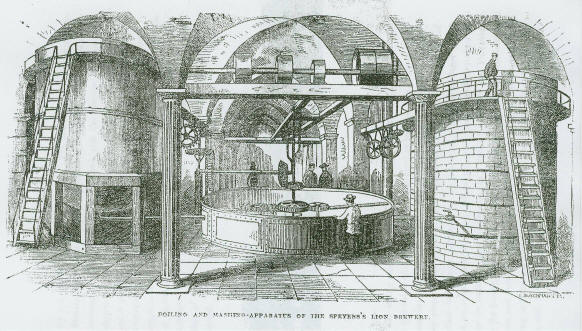Lion Ale: 1938
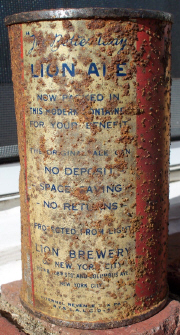
|
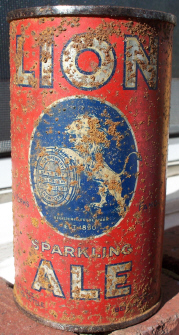
|
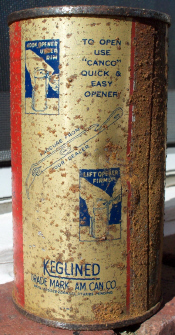
|
Lion Brewing: 1852-1941
In 1850 recent Swiss German immigrants August Schmid and Emanuel Bernheimer founded the Costanz Brewery at East 4th Street near Avenue B. The brewery specialized in lagered beer, a favorites among their fellow immigrants. By 1852, their success encouraged them to build a second Costanz Brewery at Four Corners in Staten Island, then home to a large German immigrant community. Eight years later, Bernheimer became the partner of another German immigrant, James Speyers, in his Lion Brewery, established in 1857.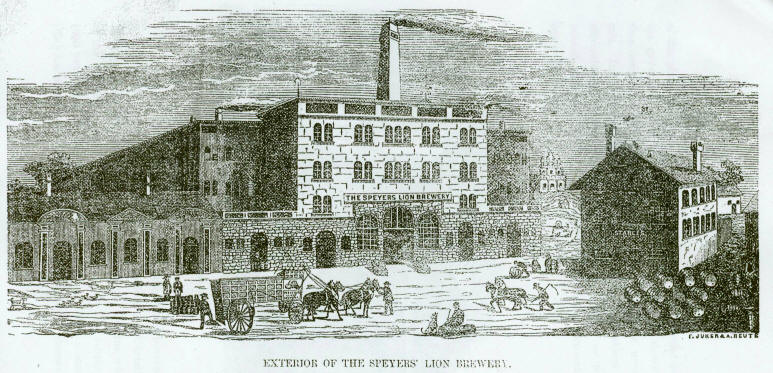
The Brewery Exterior.
The Lion Brewery, depicted here, occupied a site bounded by what are now Central Park West and Amsterdam Avenue and extending from 107th to 109th Streets. The background view includes Central Park, with a glimpse of the Blockhouse, a relic from the War of 1812. (The Church of the Ascension is there now, built with the brewery's help in the 1890s). During this period Manhattan's Upper West Side was a relatively open area offering inexpensive land and it accommodated numerous public institutions including an insane asylum. Also clustered in the neighborhood were the shanty homes of between 5-10,000 thousand people displaced by the formal opening of Central Park in 1859. The combination of shanties, public institutions, and such foul-smelling industries as breweries explains why the Upper West Side failed to develop the real estate value of other areas bordering Central Park until the early twentieth century.
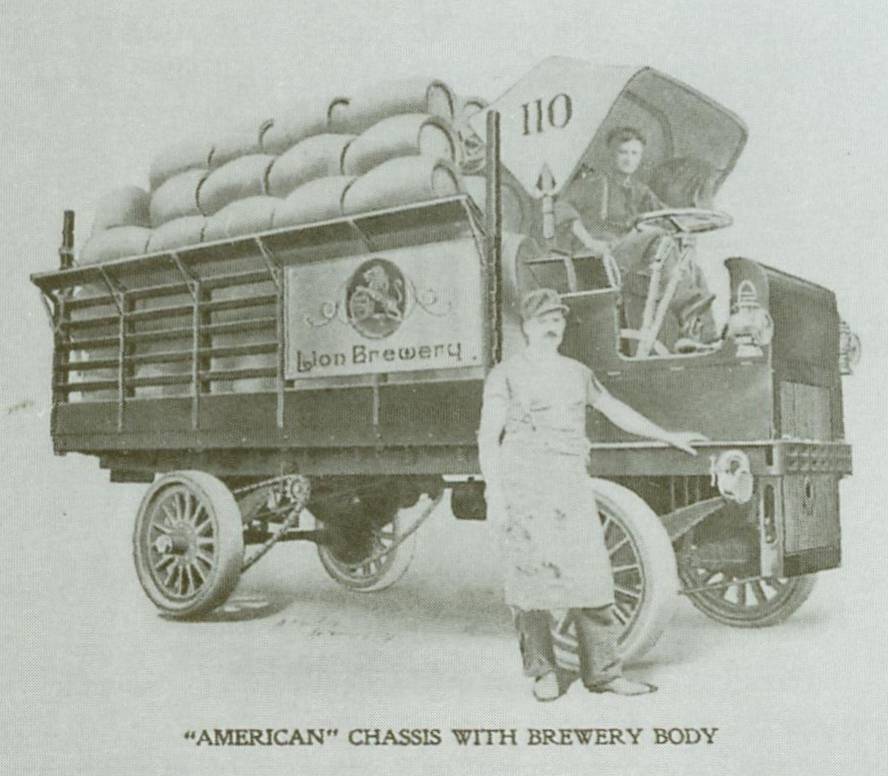
Pre prohibition era Lion Beer truck.
Smithsonian Institution.
The Internal Revenue Act in 1862, passed to help finance the Union during the Civil War, included a one dollar tax on each barrel of beer. The extra tax drove some small brewers out of business, but larger operations, such as the Lion, flourished. The anti-saloon movement in the later half of the 19th, and early part of the 20th centuries also helped business as brewers including Lion worked to clean up the saloons which were tied to individual breweries. The Lion Brewery continued to operate at the 107th Street site until 1941, when the business folded. The brewery complex was demolished in 1944 when the metal in its frame was recycled and used in the war effort.
(below) Lion Brewery advertisement from August 1936, offering distributorships.
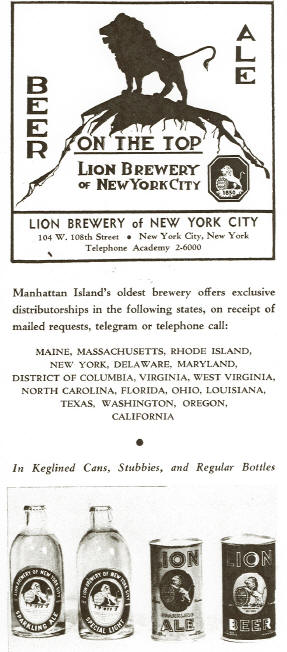 |
The Greater New York Brewery, Inc.
Lion brewing got caught up in a wave of mergers and closing among some of the smaller New York Brewers in the early 1940s. In late 1940, the Fidelio Brewing Co., located at 1st Ave. between 29th and 30th Streets., closed. However, on November 15, 1940, it reopened business as the Greater New York Brewery, Inc. In December 1940, the Greater New York Brewery merged with the Horton Pilsener Brewing Co., which was located at Amsterdam Ave. and 128th Street. Horton Brewing President Alex White became a director of Greater New York Brewery and they continued producing previous Horton products. In January 1941, the Greater New York Brewery merged with City Brewing Corporation of Queens. In February of 1941, Horton, as part of Greater New York Brewery, closed its doors. On April 9, 1941, City Brewing Corporation, as part of Greater New York Brewery, temporarily had its license canceled because of illegal merchandising in the form of gifts to retailers. (It apparently reopened at a later date.)
In May of 1941, Greater New York Brewery, Inc. acquired the Lion Brewery. It was the only brewery of the four that merged that had facilities to package beer in flat top cans. But by February of 1942, the Lion Brewery was closed and put up for sale. There being no buyers, the brewery (including the canning facilities) was auctioned off on August 26, 1943. In 1944 over 3,000 tons of steel were taken from the original brewery structure and recycled for the war effort. In April, 1946, the Greater New York Brewery, Inc. became known as the Greater New York Industries. This entity remained in operation until 1950.
For its short lifetime the former Lion Brewery continued to produce beer in cans labeled as products of the Greater New York Brewery. The two flat tops produced are scarce, but not truly rare. However, during its short life span, the Greater New York Brewery also produced a very rare crowntainer and two rare quarts containing Lion beer and ale. There are only 3 of the Beer quarts known today and the Ale is not much more common. Another rare Lion can, a Lion Pilsner, was produced by Pilser Brewing in New York in the 1940s, but I do not yet know this company's relationship to the original Lion Brewing. Today, apartment houses occupy the Lion brewery's former location.
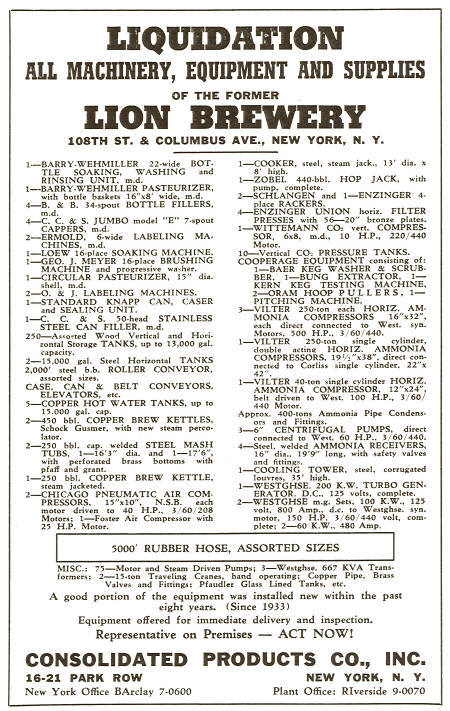 |
Advertisement from February 1942 listing items for sale in the closed Lion Brewery.
_________________________________
 |
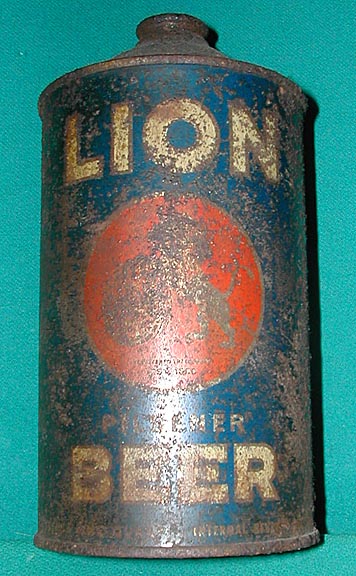 |
The scarce Lion Ale quart, 1941. The blue Lion Beer quart is RARE,, there are only three known!
Lion Brewing, Name Changes.
Speyers and Bernheimer. Lion Brewery: 1860-1862
Bernheimer & Schmid, Lion Brewery: 1862-1890
Bernheimer & Schmid: 1890-1903
Lion Brewery of New York City: 1903-1920
Lion Brewery of New York City: 1933-1941
The Greater New York Brewery, Inc.: 1941-1942
The Lion Brewery: 1860
In about 1860 or so the brewery published a pamphlet titled "Observations on Brewing and Beer: With an Analysis and Scientific Testimony Relative to the Lager Beer of the Speyers' Lion Brewery." The pamphlet had a short history of the different kinds of beer, and an analysis showing that their lager beer was pure. The pamphlet also included some great line drawings of the brewery complex.
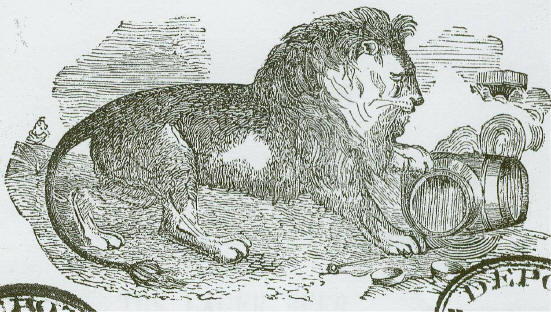 |
The old Lion Brewery Logo. |
|
Boiling and mash rooms. |
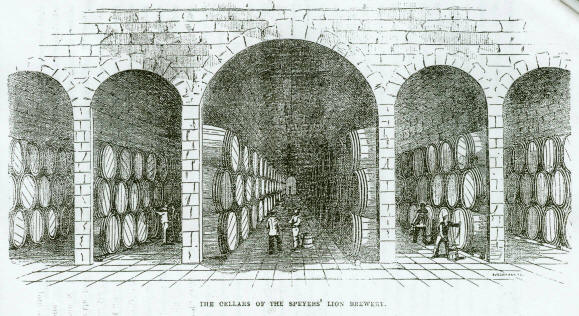 |
The brewery cellars.
|
Sources Used:
Beer Can Collectors of America. United States Beer Cans. (Beer Can Collectors of America: Fenton, Mo) 91, 196, 214.
Beer Can Collectors of America. Catalog of American Beer Cans. (1993)
Museum of the City of New York web site. They have a nice painting of the brewery in 1875.
"Observations on Brewing and Beer: With an Analysis and Scientific Testimony Relative to the Lager Beer of the Speyers' Lion Brewery." ND (1860) New York.
Stark, Dave., "Perspective" Brewery Collectibles (December-January 1984) 24.
Van Wieren, Dale P. American Breweries II (West Point, PA.: East Coast Breweriana Association, 1995) 240-241, 243, 245.
Thanks to Dave L., Marc T., Mike S., Matt M., Andy G., the Rustmonger, the Candog and the Can Dr. for the extra info on where Lion cans have been dumped.
Thanks to Matt M. for the photo!
Thank you also once again to the New York Historical Society.
Thanks to Bill G. for noting the location of the Church of the Ascension for me.
Thank you also to Paula, August Schmid's great-great Grand-daughter, for the correction! He was Swiss German.

